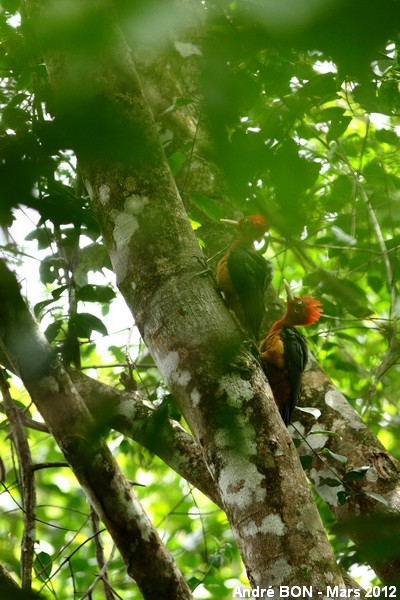

| Red-necked Woodpecker (Campephilus rubricollis (Boddaert, 1783)) |


|
|
Scientific name: Campephilus rubricollis (Boddaert, 1783) Common name: Red-necked Woodpecker French name: Pic à cou rouge Order: Piciformes Family: Picidae Size: Body size: 30 to 32 cm; Weight: 178 to 236 g. Habitat: Amazonian forest with a preference for the tall primary forest. Food: Insectivorous. The Red-necked Woodpecker looks for food along trunks and branches at a low or medium height. It feeds on larvae found in dead trunks and also on beetles and moths. Nesting: Nesting holes are excavated rather high in tree trunks. The opening is oval-shaped. Nesting occurs between January and May in the northern part of the range, later in the year further south. Migration: Sedentary. Geographic area: Venezuela, Colombia, Ecuador, Guyana, Suriname, French Guiana, Brazil, Peru and Bolivia. |
The Red-necked Woodpecker is a large woodpecker with the head, the neck and the beginning of the mantle of a bright red colour. The bill is whitish grey to ivory coloured. Males show a small black and white oval-shaped patch near the ear opening. Instead of this, females show a long white moustache extending from the base of the bill to the back of the neck. This moustache is outlined with a thin brown line. The upper parts are blackish brown. The under parts are pale rufous. The under side of the tail is blackish brown. The drum, very strong and short, is only a double-rap. Other woodpecker species with a possible confusion have marks on the back. |
| [To know more about the Red-necked Woodpecker] [Next picture] [Top] |

|
I have shot this picture at Matoury, while walking along the Mirande footpath. One family group of three or four woodpeckers has been disturbed when we passed on the footpath. I had a small window of three or four seconds with the possibility of shooting nice pictures. Unfortunately I have not been fast enough to get the woodpeckers in the viewfinder and shoot. I had then to deal with the barrier of dense vegetation and with a strong back lighting. This one is a male. You can see the small white oval-shaped patch on the ear opening area. |
| [To know more about the Red-necked Woodpecker] [Previous picture] [Top] |

|
Are these two woodpeckers, which appeared to me as smaller than the one on the first picture, juveniles? |